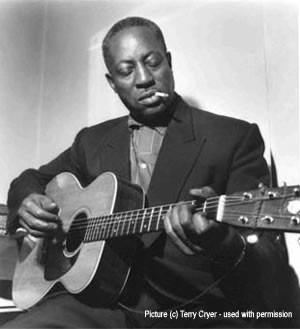An intelligent, versatile early-blues guitarist, Big Bill Broonzy possessed a distinctive, hollering voice and remarkable range. Big Bill Broonzy was born William Lee Conley Broonzy, in Scott, Mississippi, across the Mississippi River from Arkansas. Broonzy’s parents were sharecroppers who moved around the country to help in the fields. Broonzy was taught how to play the cigar box fiddle by his uncle. As a teenager, Broonzy played in several local churches and community dances as well as in a string band. Broonzy enlisted during World War I and moved to Chicago in 1920 where he worked for many years in the factories. He met Papa Charlie Jackson in 1924, a New Orleans native who was a pioneer of blues recording for Paramount. Jackson took Broonzy under his wing and taught him how to play guitar. He also used him as an accompanist. Broonzy was denied for his entire 1926 Paramount session. However, he returned to Paramount in November 1927 to get his first record, House Rent Stomp onto wax. Broonzy decided to change his recording name from Big Bill to Big Bill after one of his first records was released with the garbled title of Big Bill Broomsley. This was his record label until the second World War. On his first releases, Big Bill Johnson, Sammy Sampson and Slim Hunter were all used as aliases for Big Bill. Although Broonzy’s early records did not show any promise, this would change soon. The Hokum Boy’s disbanded in 1930. Georgia Tom Dorsey, a Georgian, decided to keep the band going and brought in Big Bill and Frank Brasswell as replacements for Tampa Red. They were known as the “Famous Hokum boys”. Broonzy found his groove with Georgia Tom and Brasswell and wrote his first great blues song, “I Can’t Be Satisfied”. This song was a huge hit and helped Broonzy to make his mark with record companies. Although 1932 was the worst year for the record industry, only half a dozen blues artists recorded any records. Big Bill was one of them, with 20 sides. Big Bill, through Georgia Tom and Tampa Red met Memphis Minnie. He toured with her as her second guitarist during the 1930s but did not record with them. In March 1934, he began recording again for Bluebird’s Chicago studio. It was under Lester Melrose. Broonzy’s style appealed to Melrose, who soon made Big Bill Melrose his unofficial second in command. He would audition artists, match numbers with performers, book sessions and provide backup support for other musicians. In the late ’30s and early ’40s, he was involved in hundreds of Bluebird records, including those by his half-brother Washboard Sam, Peter Chatman (aka Memphis Slim), John Lee Williamson and others. Broonzy and Melrose helped to create the “Bluebird Beat,” a popular type of blues record that featured trap drums as well as upright string bass. This was the beginning of the “Maxwell Street sound” (or “postwar Chicago Blues”), and helped to define the music in a way that was popular in the cities. Ironically, Broonzy’s recordings as a singer, while he was working for Melrose at Bluebird were primarily made by ARC and then Columbia’s Okeh subsidiary. This was Broonzy’s most prolific period. He recorded and wrote songs such as “Key to the Highway”, “W.P.A.” and “Unemployment Stomp.” Blues,” All by Myself,”and “Unemployment Stomp” were some of his most memorable songs. Broonzy also wrote songs for other artists such as “Diggin’ My Potatoes.” Big Bill Broonzy was responsible for more than 100 original songs. John Hammond was looking for a traditional blues singer to perform at his Spirituals to Swing concert at Carnegie Hall in New York City. He had already found Robert Johnson. Hammond discovered that Johnson had just died and Big Bill was given the opportunity to perform at Carnegie Hall on Friday, February 5, 1939. The appearance was well-received and Broonzy was given a part in George Seldes’ 1939 film Swingin’ the Dream, alongside Louis Armstrong and Benny Goodman. Big Bill was busy touring with Lil Greenwood and appearing at the Cafe Society, Village Vanguard, Apollo Theater, and Village Vanguard in the early ’40s. The operation in Chicago with Melrose was finally winding down by the middle-to late ’40s as the electric blues began to heat up. Big Bill continued to record on labels that included Mercury and majors Columbia, as well as fly-by-nights like RPM and Hub. Broonzy took a break from music in 1949 and worked as a janitor for the Iowa State University of Science.
